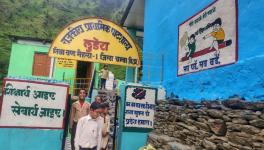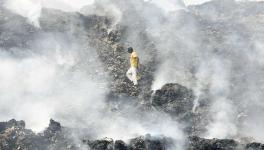Water Woes: Cities Made to Accept Terms They Aren’t Even Aware Of
Image Courtesy: Flickr
Splintering urbanism is a reality that has roots in the neo-liberal paradigm of urbanisation, which started nearly three decades back in India. Cities have suffered from the fragmentation of access, control, and pricing of network infrastructure, including water supply. The fragmentation is due to political-economic processes-neoliberalism-that have changed the ways cities are governed and services provided.
Indian cities are splintering because of macroeconomic and political trends, such as high levels of debt that reduce the fiscal capacity and extend government services. These trends create ideal conditions for private companies to aggressively seek new markets.
The above understanding is quite universal across the globe and has been well documented in a book titled “Water Privatisation”.
Similar processes are undergoing with the Shimla water utility.
Shimla water utility, currently called the Shimla Jal Prabandhan Nigam Limited (SJPNL) has an interesting story of development and qualifies the above statement -- water being used as a commodity for profit maximisation.
How it Developed
The transformation from Shimla Water Works to Greater Shimla Water Supply and Sewerage Circle (GSWSSC) (utility as conceived in 2016) took place during the term when this writer had the opportunity to serve the Shimla Municipal Corporation (MC) as Deputy Mayor.
The formation of this utility was not planned and, in fact, evolved from an accident. This was the outbreak of hepatitis in the city, which had led to several deaths and hundreds falling sick. There were three major options to go ahead with: first, the model of Delhi Jal Board, second, to hand it over to the state government and third, to form a utility under the Shimla Municipal Corporation with a fair amount of autonomy-- both fiscal and administrative.
The then MC chose the last option and after many back-to-back meetings with the state government and the World Bank, a tripartite agreement was reached. This is how the GSWSSC came into being. Financial support of $ 250 million was agreed upon landing on three major tasks -- lifting water from the Satluj River, improving water distribution, and wastewater treatment. Of the $250 million, $90 million i.e., 36% was supposed to come from the government of Himachal Pradesh.
In 2017, a new MC cabinet was sworn in. In the same year, Congress lost the state elections and Bharatiya Janata Party (BJP) won.
There was BJP in the Shimla MC and the state government. They decided to transform it into a company and transferred all the assets to the newly formed SJPNL. The company was registered with an equity of 51% share of Shimla MC and 49% of the state government. However, the administrative control was completely in the hands of the state government. A board of directors was formed with the chief secretary as the chairperson. It was astonishing that the chief secretary, who has to look after the state, was overviewing the works of a utility for a town!
The basic theory for the transformation that the previous government advocated is: “For effective, autonomous WSS institution, embedded in a policy framework that incentivizes efficiency, accountability, and performance.”
However, sheer cronyism and massive corruption at the behest of the previous government and officers, falling standards of work, and completely inefficient management are the reality.
What is this Project all About?
The project is part of the Development Policy Loan (DPL) from the World Bank. In 2017, the utility shifted from the government to a company. The bulk water supply from Satluj River should have been completed by now. But what has happened? In order to favour the contractor company(owner), the conditions of the tender/ contract agreement were overlooked. The company was awarded the tender to lift water from Satluj to Shimla.
-- Though the process started in March 2018, the award was made only in October 2020. One can see the efficiency of the company. One of the reasons for awarding this contract to the aforesaid company is the close association of the then-ruling dispensation with the company leadership. It has been five years since the process began, however, water has still not reached and not even 10 % of the work has been completed.
-- There is a basic problem with the design of lifting water. The region from Sunni to Shimla falls in Seismic zone IV and the commensurate design of the construction should have been followed. However, this is not being done. One can imagine the huge losses that are going to happen once an earthquake strikes.
--Till date, there is no System Improvement Plan (SIP), which is the basis for any scheme to execute. Without an SIP, project execution permission is like a ‘disaster in the offing’.
-- In order to benefit the executing company, the project cost was revised from Rs 250 crore to Rs 500 crore. This was a huge benefit made to the executing company and a straight loss to the exchequer. The chief secretary handling a water utility does not make sense at all.
Performance-Based Contract
The other major scandal in the offing is the tender floated by the urban development department for a performance-based contract, simply for the rejuvenation of the existing infrastructure of distribution in Shimla.
The tenders have been called three to four times in the past. Every time the conditions of the tender are changed.
Last time, just before the Assembly elections, the previous government, in a hurry to pass on the award to a particular favourite (which is a foreign company), did not even give credence to the Code of Conduct. However, after a hue and cry was raised by different quarters, the tenders were cancelled.
Now, once again the tender has been floated and there have been blatant violations in determining the conditions of the tender. This is being done to favour just one crony of the previous government and some of the officers who are hell-bent on awarding it to a particular company.
What are the main problems with the current tender? First, it is not based on any realistic Detailed Project Report (DPR). There is no appraisal of the existing system of the network. As one would recall during the regime when P K Dhumal was Chief Minister (BJP), a good number of pipes had already been laid. What will happen to that network?
One of the important conditions that should have been kept in the tender is that those who have the experience of handling or executing work with a utility in the mountains should have been given credence. However, no such clause exists in the tender document.
Other problems
It has been five years, and to date, the R&P (recruitment and promotion) rules have not even been formulated. This company is working on ad-hoc basis, and merit is completely overlooked.
There is no ownership of/in the company. The chief secretary is not supposed to take care of a utility in a town. This should be under the democratic control of the elected institution if at all this has to exist. In fact, the company model must be scrapped immediately.
All that is happening is image building by doling out money from the public exchequer.
In the absence of R & P rules, retirees are ruling the roost. That is not a problem, but this is not a sustainable way of running a utility. There is a complete mismatch in the wage structure as well. Some of the workers who are attending calls are paid Rs 60,000 per month, which is good, but those who are working at pump houses, sewage plants, etc., are paid only Rs 8,000/month.
Because it is not under democratic control, there is massive corruption; arbitrary decisions and inept efficiency are leading to the failure of the utility.
Himachal Pradesh has shown the world that the government does function. Recall the period of Y S Parmar, the first and founder chief minister of the state; even when large parts of states are championing “ease of doing business” it still lacks electricity. The state was 100% electrified in the 1980s, and all that happened under the stellar leadership of Parmar and others.
The current model needs to be inversed; for neither is it economically, financially, or environmentally sustainable, nor is it in the interests of the people.
The writer is the former deputy mayor of Shimla, Himachal Pradesh. The views are personal.
Get the latest reports & analysis with people's perspective on Protests, movements & deep analytical videos, discussions of the current affairs in your Telegram app. Subscribe to NewsClick's Telegram channel & get Real-Time updates on stories, as they get published on our website.
























